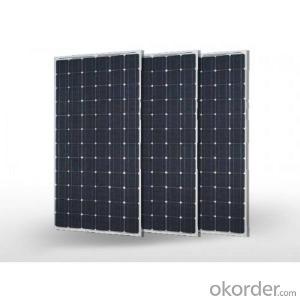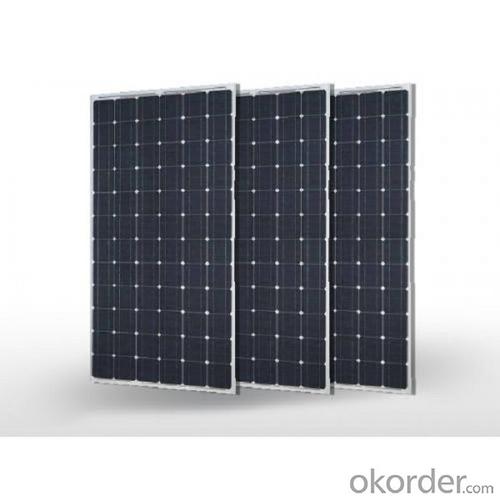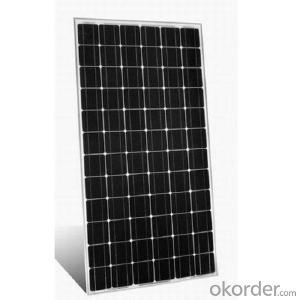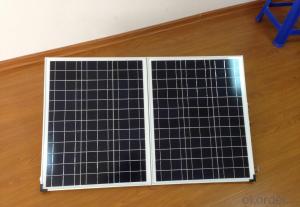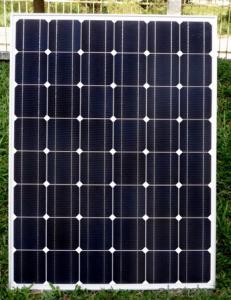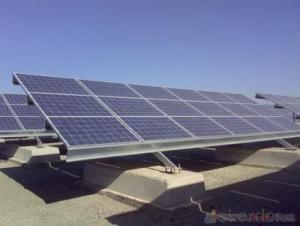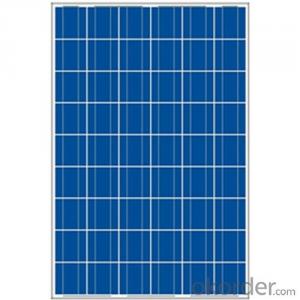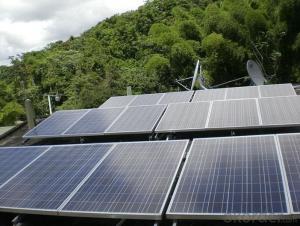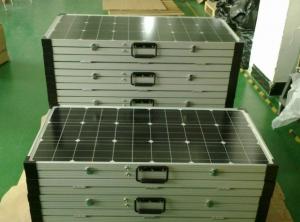Xkcd Solar Panels Mono260W Solar Panel Price in China
- Loading Port:
- Shanghai
- Payment Terms:
- TT OR LC
- Min Order Qty:
- 2600 watt
- Supply Capability:
- 26000 watt/month
OKorder Service Pledge
OKorder Financial Service
You Might Also Like
Specification
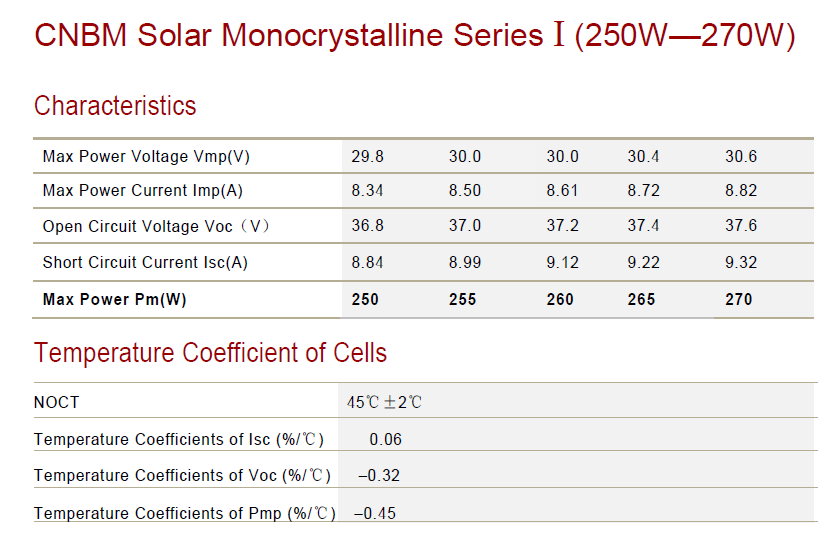
| Rated maximum power (Pmax) | 200W |
| Open circuit voltage (vOC) | 45.43 |
| Short circuit current (Isc) | 5.56 |
| Maximum power voltage (Vmp) | 37.94 |
| Maximum power current (Imp) | 5.24 |
| Cell efficiency (%) | 18.00% |
| Max system voltage (VDC) | 1000V DC |
| Temperature coefficient of Vm | -0.241%/K |
| Temperature coefficient of Im | 0.033%/K |
| Temperature coefficient of power | -0.37%/K |
Solar panel working process
In addition to being the ultimate source of all life on earth, the sun is an infinitely renewable, completely pollution-free source of electricity. Instead of burning fossil fuels dug up from the ground in a big power plant – a very 19th century, industrial age approach, when you think about it – solar panels convert sunlight directly into electricity, with no harmful emissions.
The basic unit of a solar panel is a solar cell, which usually consists of one or two layers of silicon-based semiconductor wafers. When struck by the photons in sunlight, the solar cell generates an electrical charge due to the "photovoltaic effect" – which is a pretty good name, since it produces voltage from photons. The flow of these electrons moves in a steady electrical current from one side of the cell to the other.
Dozens of these PV cells are packaged together into solar modules, which in turn are packaged into solar panels that are mounted on a rooftop and arranged to maximize their hours of exposure to direct sunlight. Because the electricity generated by all those solar cells is direct current (DC), it is then sent to an inverter that transforms the power into the same alternating current (AC) used by the appliances in your home and the local utility electricity distribution grid. Increasingly, these inverters are getting "smart," providing data monitoring for solar installation performance and other grid integration services.
FAQ
We have organized several common questions for our clients,may help you sincerely:
③Can you provide the peripheral products of the solar panels, such as the battery, controller, and inverter? If so, can you tell me how do they match each other?
Yes, we can, we have two companies for solar region, one is CNBM International, the other is CNBM engineering Co.
We can provide you not only the solar module but also the off grid solar system, we can also provide you service with on grid plant.
④What is your warranty system?
Our product performance guarantees for 25 years
• 12 years guarantee for workmanship
• Timeliness of delivery
• Quality Products certified (TÜV, UL, CE, ISO)
- Q: Can solar panels be installed on the ground?
- Yes, solar panels can be installed on the ground. Ground-mounted solar panel systems are a popular alternative to rooftop installations, especially in areas with ample available space. They are often used for large-scale solar projects, such as solar farms or commercial installations, but can also be installed in residential settings if space allows. Ground-mounted panels offer flexibility in terms of orientation and tilt angle, optimizing energy production.
- Q: is a wind turbine better than solar panels
- is your place has enough wind or sunshine ? the turbine is not easily for maintenance. the solar panel is more stable, one broken panel willl not affect the whole system much
- Q: How do solar panels affect roof maintenance?
- Solar panels can have both positive and negative effects on roof maintenance. On one hand, solar panels provide an additional layer of protection to the roof, shielding it from elements like rain, snow, and UV rays, which can extend its lifespan. On the other hand, regular maintenance of the solar panels themselves, such as cleaning and inspection, may require occasional removal or adjustments, which could potentially impact the roof. Overall, proper installation and regular maintenance of both the solar panels and the roof are crucial to ensure their optimal performance and longevity.
- Q: Can solar panels be used in developing countries?
- Yes, solar panels can definitely be used in developing countries. In fact, they are increasingly being adopted as a sustainable and affordable source of energy in many developing nations. Solar power offers numerous benefits such as reducing reliance on expensive fossil fuels, providing electricity to remote areas without access to the grid, and promoting economic growth by creating job opportunities in the renewable energy sector. Additionally, solar panels can be easily installed and maintained, making them a viable solution for powering homes, schools, healthcare facilities, and other essential infrastructure in developing countries.
- Q: Can solar panels be used to power a train?
- Yes, solar panels can be used to power a train. Solar panels generate electricity by converting sunlight into energy, which can be used to power various systems, including trains. However, the feasibility and efficiency of using solar panels to power a train will depend on several factors such as the size of the train, the available surface area for solar panel installation, the train's energy requirements, and the geographical location's solar potential.
- Q: I riped two solar panels out of some solar light and tested them. I found out that they both produce 2 volts(I have no idea on the watts or amps). Iquot;ve hooked them up to an electric motor that can be driven by a AA battery, but when I hook the solar panels up to them nothing happens. What is wrong?
- The solar cells you have are not providing enough current to operate the motor. There are special low power motors which can operate directly from a solar cell but it sounds like you do not have one of these. Instead you have a common .5V DC hobby motor which requires substantially more current to operate. You can use the original circuit to charge the batteries and use the charged batteries to run the motor. The batteries would be able to supply enough current to operate the motor, but for a limited time. 8 hours of charging might give you less than 5 minutes of motor operation. An LED will draw about 20ma. In a solar light such a small current draw from an LED or two can provide hours of light. A Small DC motor might easily require 300ma to run and over 500ma to start. Running a motor from the same battery at over 5 times the current draw will result in less than /5 of the run time compared to the low current LED. So if an LED operates for 300 minutes the motor would run for less than 20.... The small solar cell size cannot provide enough current to operate the motor directly. Only by slowly charging a battery first would you be able to use the collected and stored Solar energy to operate your motor.
- Q: I want to purchase some or one solar panel for my home. I don't know where to buy them from. I've loooked online and if i could buy them online that would be best, but if you knew of a website that has good prices than that would be great!Thanks
- Are you aware of the complications that go along with installing a solar system? A solar panel might put out about 00 watts at 24 volts DC. What would you use it for. The typical solar system has a lot of panels connected in series. The output is connected to an inverter to make 20-240 volts AC. This is connected to the power grid if it is to be used. Also if it is felt that the system should provide power during an electrical outage, there will be batteries. How big would you wan it to be? Mine has forty panels with two inverters. It supplies all the electricity for the house, with some left over to supplement my gas heat. Read the Q and A in the Search box at the upper right of this page, by searching for solar panel. Also study all you can get your hands on.
- Q: The inverter I am using gets the required 2 DC volts from the solar panel, but fo some reason it just won't output the 0 AC voltage. When the inverter is hooked to a car battery, it works just fine off the same 2 DC rating. Help me out please...
- There could be a couple of reasons why it isn't working. First, 2V panels actually put out a considerably higher voltage because it is presumed that they will be used to charge a 2Vdc battery. That requires applying a voltage greater than 2Vdc, and usually there is a solar controller that regulates the solar power to the battery. It also has a voltage drop. Look at the first reference reference, and you will see these values for a particular panel: Voc: 2.6V (open circuit voltage) Vmp: 7.2V (voltage at maximum power point) Voc is the voltage the panel produces under standard sunlight and temperature conditions (25°C), with no load applied. As load is applied, the voltage drops (see reference 2). Power is the product of current times voltage, so at one set of conditions (namely at Vmp) maximum power is available from the panel. Your inverter might not be working for either of two reasons: ) it has input protection circuitry that locks out operation when it senses an overvoltage, as in the 2.6V open circuit voltage, or 2) the panel does not produce enough current and the voltage from the panel collapses under excessive load. For example, if you load your inverter to 20W, then nominally the 2VDC input to the inverter must supply 20W/2V/eff = 0A/eff Assuming the inverter has an efficiency of 80%, the input current required is: 0A/.8 = 2.5A A solar panel operating at maximum power would need a rating of about: 2.5A x 7.2V = 25W Is your panel that big? The other option, as mentioned by others, is to charge a battery that runs the inverter. Other nuances: Voc increases as temperature decreases. Sunlight intensity varies (obviously), so the panel may produce less than rated power. The power specifications often are printed on the back side of the panel.
- Q: if you know the area of the panel can u calculate for the wattage or voltage of the panel..
- You need to know how many solar cells are in the panel and what is the rated current each cell will produce. This information should be listed on the panel. Each cell will produce from 0.5 to 0.55 volts DC per cell and each cell will produce a current that is dependent on the size of the cell and the type of material the cell is made from. If the cells are connected in series then the voltage of each cell will add together, that is if you have 30 cells connected in series they should generate about 5 to 6.5 volts DC. If each cell generates .2 amps, then you multiply the voltage of 5 volts DC times .2 amps DC equals 8 watts of power. The current of each cell does not add together when you connect the cells in series only the voltage of each cell. If you connect the 30 cells in parallel then the current of each cell adds together but the voltage of each cell does not. That is 0.5 Volts DC times 36 amps equals 8 watts. The power (watts) produced will be the same. See our blog on the products page to see how to connect solar cells in series and in parallel. We also have a PDF file of solar cells and their rated output current sorted by watts per area and their manufacturer.
- Q: With no moving parts, no fuel piping and so on...
- They are made of costly materials and require expensive manufacturing processes. The market has been limited because people are not catching on very well to the new idea. The more we buy and use solar panels, the more the price will come down.
Send your message to us
Xkcd Solar Panels Mono260W Solar Panel Price in China
- Loading Port:
- Shanghai
- Payment Terms:
- TT OR LC
- Min Order Qty:
- 2600 watt
- Supply Capability:
- 26000 watt/month
OKorder Service Pledge
OKorder Financial Service
Similar products
Hot products
Hot Searches
Related keywords
